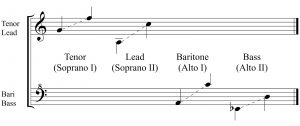So, what is this music called “barbershop”, anyway? We could not possibly provide a comprehensive description in this limited space – there’s just so much to be said! – but here is perhaps the most basic introduction to the barbershop style that you can find. Let’s take it one concept at a time.
Barbershop music is sung a cappella. That is, there are no accompanying instruments – the singers simply listen to a starting pitch and go from there with just their voices. Singers depend on their ability to hear and sing accurate intervals (to go from one note to the next with accuracy) in order to keep the song in tune and in harmony.

Barbershop music is sung in four-part harmony. There are four voices in the barbershop style, and together they sing four notes in a music chord:
- The melody of the song is sung by the Lead voice.
- The Tenor voice sings the harmony part higher than the melody.
- The Bass voice sings the lowest notes in the chord.
- The Baritone voice sings those notes which are needed to fill out the chord. Sometimes the Baritone sings higher than the Lead, but usually sings lower than the Lead.

The names of the voice parts (Tenor, Lead, Baritone and Bass) are taken from the men’s choral voice ranges. Even when women sing barbershop, we still call the voice parts Tenor, Lead, Baritone and Bass, rather than using the more common choral voice names of Soprano or Alto.

